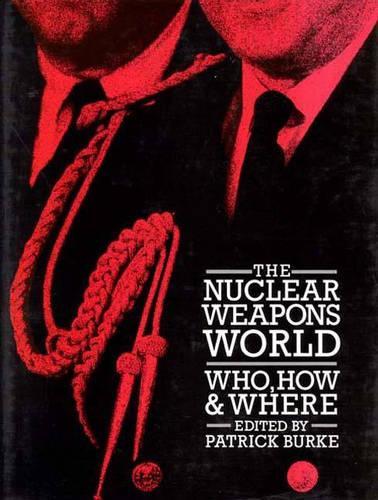
The Nuclear Weapons World: Who, How, and Where
(Hardback)
Publishing Details
The Nuclear Weapons World: Who, How, and Where
By (Author) Patrick Burke
Bloomsbury Publishing PLC
Greenwood Press
16th January 1989
United States
Classifications
Tertiary Education
Non Fiction
355.0335
Physical Properties
Hardback
398
Description
The Nuclear Weapons World: Who, How, and Where is a unique guide to nuclear weapons decisionmaking and decisionmakers in the five official nuclear weapons states and the two nuclear alliances. No other book describes in such detail the complex structures in which decisions to produce and deploy nuclear weapons are made, and lists alphabetically with full biographies the names of the 750 people who make decisions about nuclear weapons production and deployment. Case studies on nuclear weapons procurement and deployment decisions make this book informative and necessary reading for both specialists in the field and generalists seeking up-to-date information on this important subject. The Nuclear Weapons World: Who, How, and Where is a unique guide to nuclear weapons decisionmaking and decisionmakers in the five official nuclear weapons states and two nuclear alliances: the USA, the Soviet Union, Britain, France, China, NATO, and the Warsaw Pact. No other book describes in detail the complex structures in which decisions to produce and deploy nuclear weapons are made and also provides the names of the key decisionmakers. Divided into seven chapters, one for each of the official nuclear weapons states and the nuclear alliances, The Nuclear Weapons World also lists alphabetically with full biographies the names of the 750 people--scientists, armed forces members, top industrialists, permanent government officials, and politicians--who make the decisions about nuclear weapons production and deployment. Addresses and, where available, telephone numbers for entries are presented along with a full description of the decisionmaking structures: councils, committees, departments and institutes; organizational charts; descriptions of structures and biographies cross-referenced; complete name and subject indices; and a full glossary.
Reviews
. . . Reference librarians and patrons of public and collegiate libraries will appreciate this reliable compilation.-American Reference Books Annual
The Oxford Research Group (ORG), an amalgamation of academics and professional advocates for whom Burke has edited this volume, has a novel way of looking at nuclear proliferation by studying the way in which governments of the world have made decisions that are vital to everyone. Operating in secret, the defense ministers of both NATO and Warsaw Pact countries commit their separate governments to long-range, cooperative efforts in development of weapon systems. It is this process that is of great concern. This work expands upon two earlier books published under ORG auspices, How Nuclear Weapons Decisions Are Made ed. by S. McLean and Hugh Miall's Nuclear Weapons: Who's in Charge (Basingstoke, UK, 1987); both the bureaucracies and the individuals who constitute them are described. Some fascinating case studies are offered as examples of decision making. For example, the US entry concludes with a detailed examination of decision making on the B1 bomber. . . . The interesting approach, however, makes this work a vital complement to standard sources such as the annual The Military Balance published by the International Institute for Strategic Studies (1962-). Recommended to both public and academic libraries.-Choice
." . . Reference librarians and patrons of public and collegiate libraries will appreciate this reliable compilation."-American Reference Books Annual
"The Oxford Research Group (ORG), an amalgamation of academics and professional advocates for whom Burke has edited this volume, has a novel way of looking at nuclear proliferation by studying the way in which governments of the world have made decisions that are vital to everyone. Operating in secret, the defense ministers of both NATO and Warsaw Pact countries commit their separate governments to long-range, cooperative efforts in development of weapon systems. It is this process that is of great concern. This work expands upon two earlier books published under ORG auspices, How Nuclear Weapons Decisions Are Made ed. by S. McLean and Hugh Miall's Nuclear Weapons: Who's in Charge (Basingstoke, UK, 1987); both the bureaucracies and the individuals who constitute them are described. Some fascinating case studies are offered as examples of decision making. For example, the US entry concludes with a detailed examination of decision making on the B1 bomber. . . . The interesting approach, however, makes this work a vital complement to standard sources such as the annual The Military Balance published by the International Institute for Strategic Studies (1962-). Recommended to both public and academic libraries."-Choice
Author Bio
PATRICK BURKE is Researcher/Oxford Research Group, previously Business Manager and a sub-editor of the Journal of European Nuclear Disarmament.
